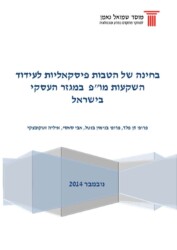This study examines the merits of incentivizing R&D investments through tax credits based on a firm’s R&D expenditures. Most OECD countries offer such incentives. The main advantage of such measures is their relative simplicity, being based on periodic tax returns while forgoing the complexities and restrictions associated with current R&D grants support programs. The study suggests adding R&D tax credits to existing R&D proposed programs, not to replace them, and points out the sectors that are likely to find such program attractive and effective.
The study includes a comprehensive review of R&D support measures offered by other countries and economic evaluations of their effectiveness. It presents an estimate of the effects of an R&D tax credit by using a simple linear model relating R&D to economic outcomes at the industry level. Employing coefficients estimated in other countries, the model predicts that each shekel of R&D tax credit generates in the long term between 1.3 and 2 additional shekels of output. In terms of returns on investment, this is equivalent to an impressive annual rate of return in the range of 30% to 100%.
The yields from R&D tax credits obtained in the model are higher in sectors with lower R&D intensity. This attribute, together with the great simplicity in applying it for this kind of support, make the R&D tax credit program highly suitable for firms in classic and classic-mixed industries, where traditional R&D projects are rare. The proposed program is expected to encourage firms to invest in various forms of R&D and technological innovation, thus improving Israel’s productivity and competitive standing in global markets. Accordingly, the study proposes to complement the impressive array of R&D support programs in Israel by adding R&D tax credit.


